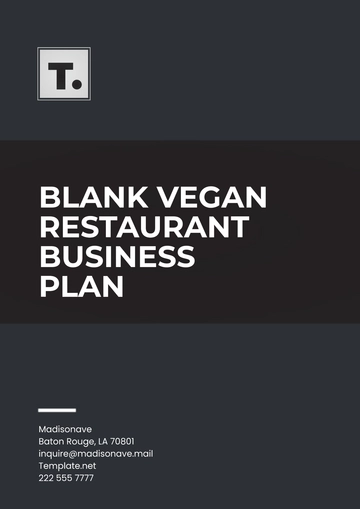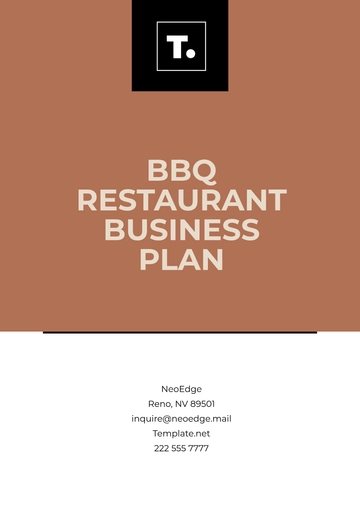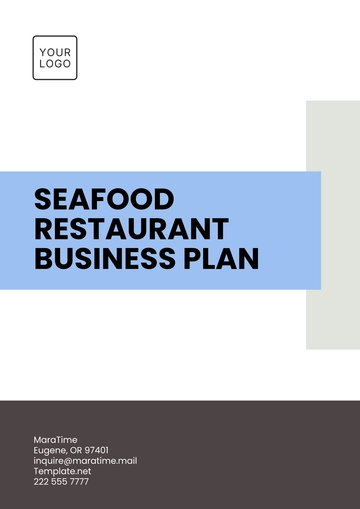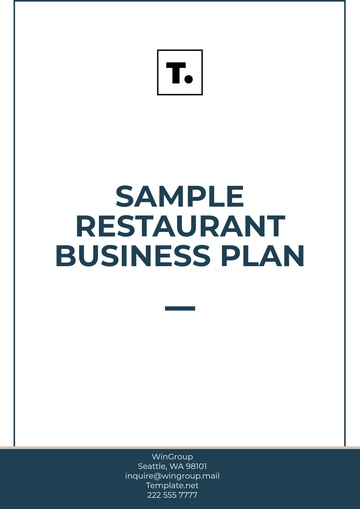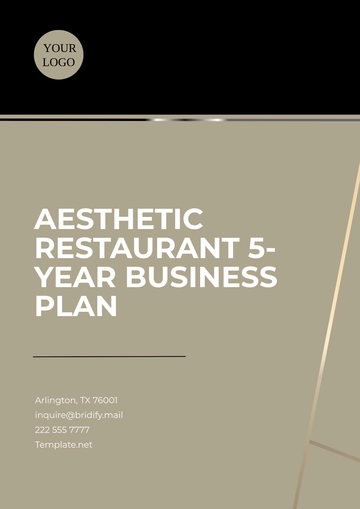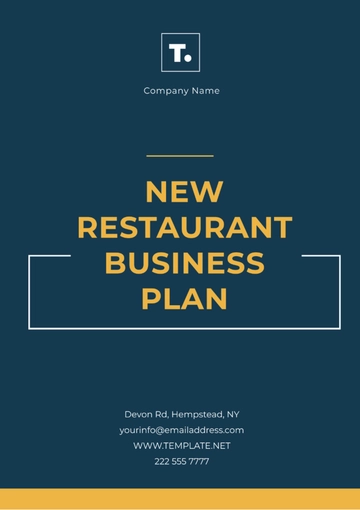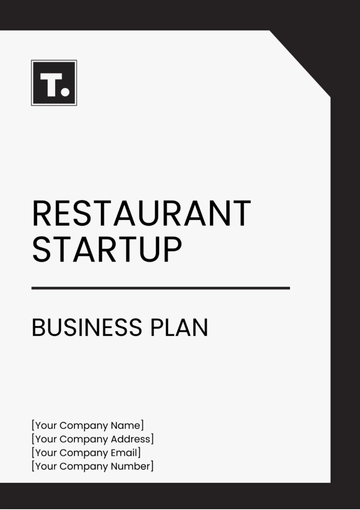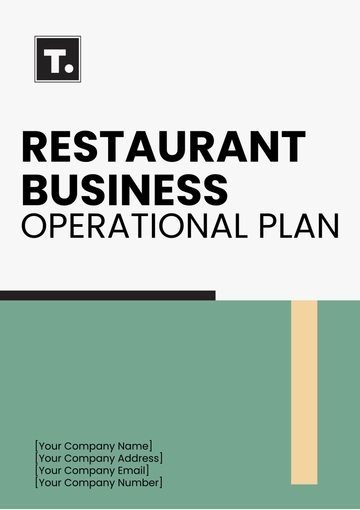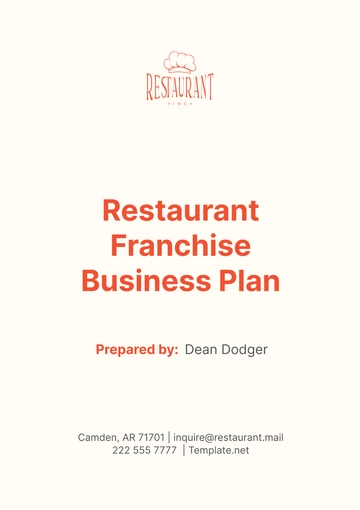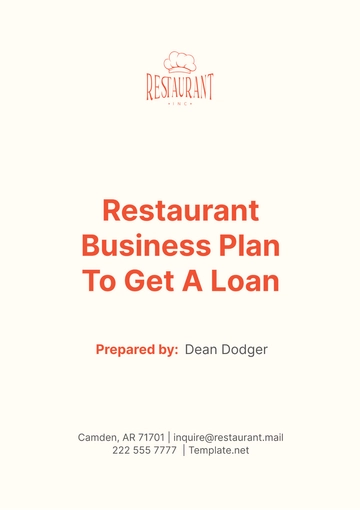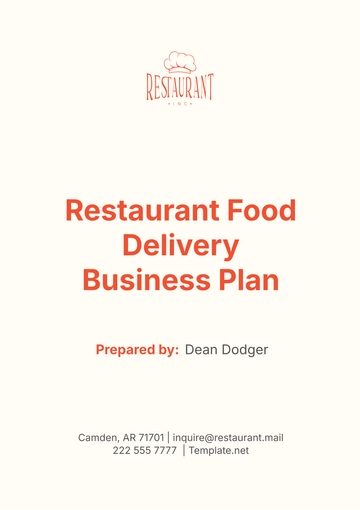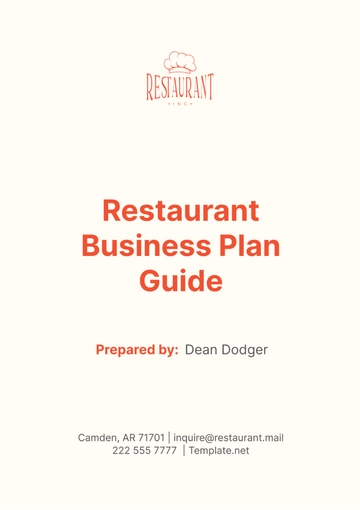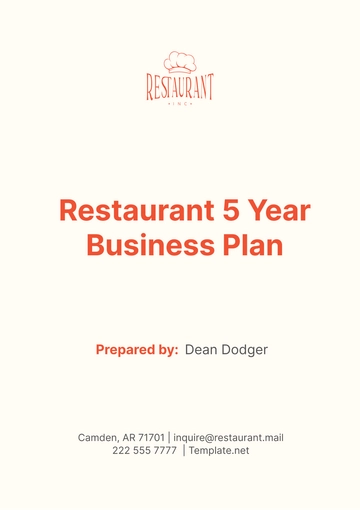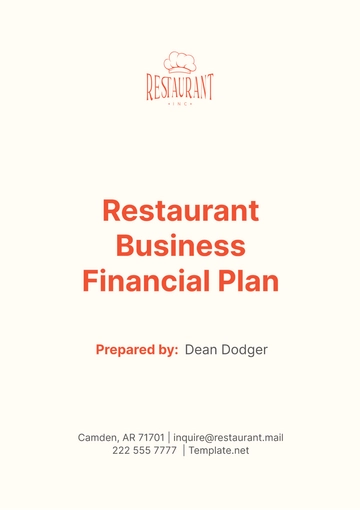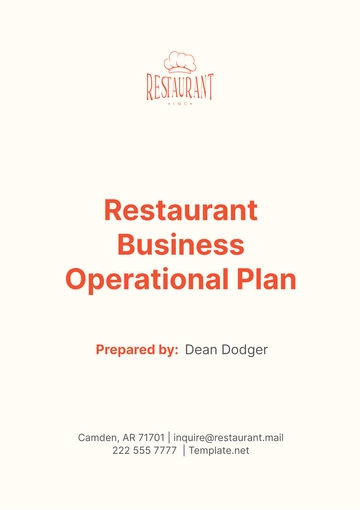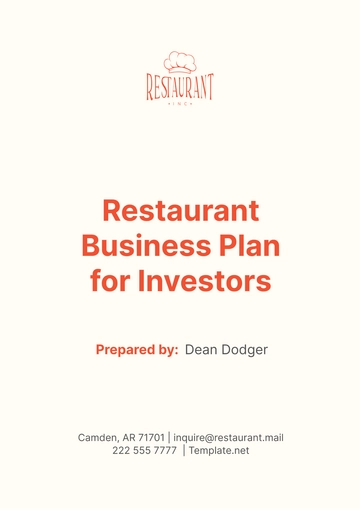Free Restaurant Business Plan To Get A Loan
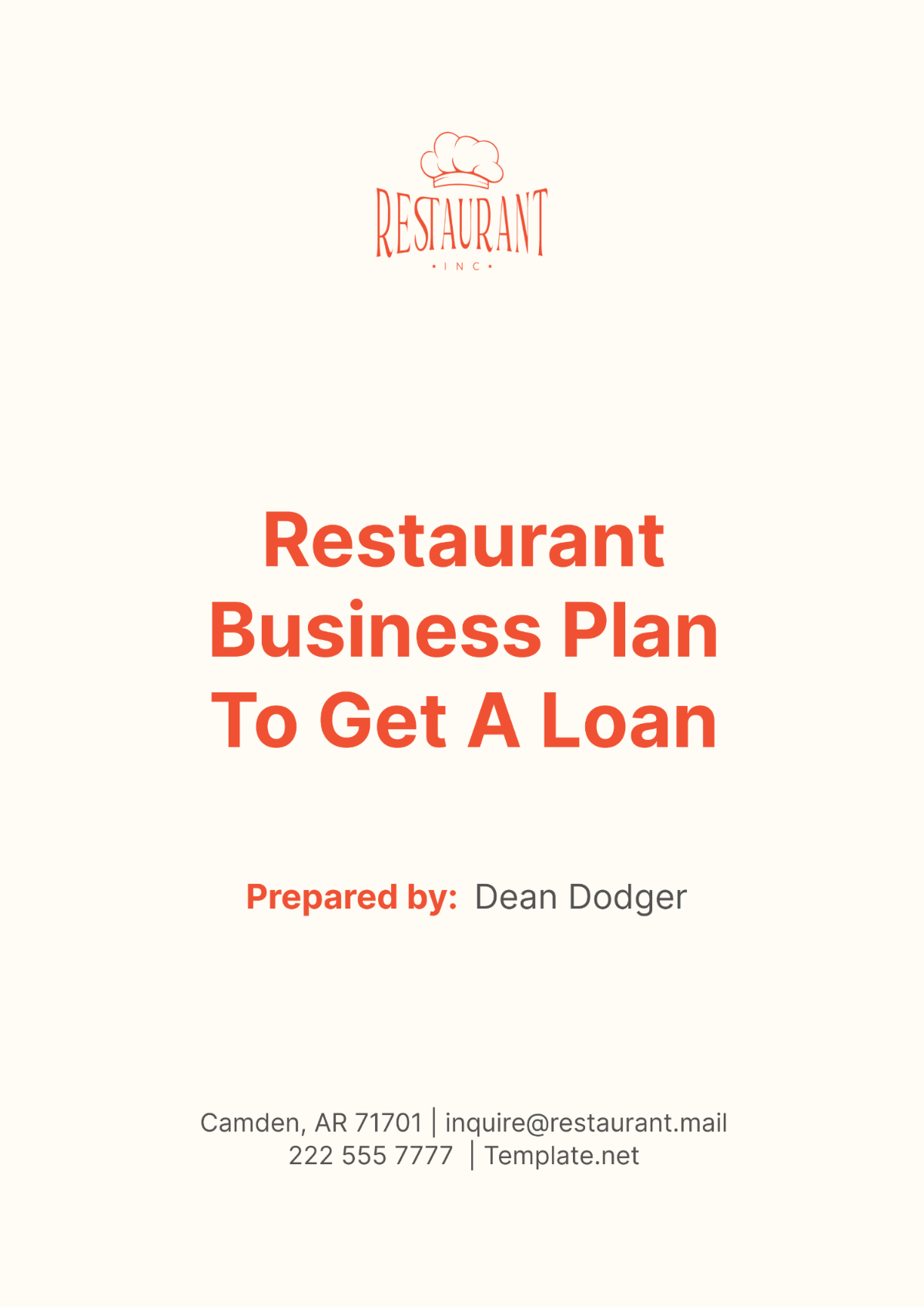
I. Executive Summary
We are a modern restaurant offering a unique dining experience centered around farm-to-table cuisine, crafted cocktails, and exceptional customer service. Our concept focuses on providing fresh, locally sourced ingredients in a contemporary setting that appeals to food enthusiasts and families alike. Our primary objective is to establish a strong presence in the community, achieve steady revenue growth, and create a loyal customer base through quality and consistency.
Financial Highlights
Initial Investment: $750,000
Projected Annual Revenue (Year 1): $1.5 million
Projected Net Profit Margin: 20%
Break-Even Point: 24 months
Loan Amount Requested: $500,000
We have identified a growing demand for high-quality, locally sourced food and aim to fill this niche with our innovative menu and commitment to sustainability. Our business plan outlines the steps we will take to ensure profitability and success, including detailed market analysis, a comprehensive marketing strategy, and robust operational processes.
II. Company Description
We were founded in [Year] by a team of culinary professionals and business experts passionate about delivering an exceptional dining experience. Our company operates as a Limited Liability Company (LLC), providing both flexibility and protection for our owners. Our chosen location is in the heart of a bustling downtown area known for its vibrant dining scene and high foot traffic. This prime location offers us excellent visibility and accessibility, which are crucial for attracting our target market of urban professionals, families, and food enthusiasts. We are committed to creating a welcoming and memorable environment for all our patrons, ensuring their satisfaction and loyalty.
III. Market Analysis
A. Industry Overview
The restaurant industry is a vital sector of the economy, generating over $900 billion in annual sales in the United States alone. The industry is highly competitive, with a significant portion of revenue coming from the fast-casual dining segment, which has been growing at an annual rate of 8%. This growth is driven by increasing consumer demand for high-quality, convenient dining options. The trend toward sustainability and locally sourced ingredients is particularly strong, with 70% of consumers expressing a preference for restaurants that prioritize these values.
B. Target Market
Our target market consists of urban professionals, families, and food enthusiasts who value high-quality, locally sourced food in a modern and inviting atmosphere. These groups are characterized by a willingness to spend on premium dining experiences and a preference for sustainable and ethical food practices.
Demographics | Needs |
|---|---|
Age: 25-50 | High-quality, locally sourced meals |
Income: $60,000+ | Premium dining experiences |
Urban Professionals | Quick, convenient, yet upscale dining |
Families | Kid-friendly options and comfortable seating |
Food Enthusiasts | Innovative and unique menu offerings |
C. Competitive Analysis
The competitive landscape in our area includes several well-established restaurants, each with its own strengths and weaknesses. Our focus on farm-to-table cuisine and sustainability provides us with a distinct competitive advantage.
Competitor | Share | Strengths | Weaknesses |
|---|---|---|---|
A | 20% | Strong brand recognition | High prices |
B | 15% | Extensive marketing campaigns | Service quality |
C | 10% | Large variety of menu options | Sustainability |
Our restaurant stands out due to our unwavering commitment to quality, sustainability, and a superior dining experience. We occupy a unique niche by emphasizing locally sourced ingredients and innovative menu offerings, which resonates with our target market. Currently, we aim to capture a 10% market share within the first year of operations, leveraging our distinct competitive advantages to attract a dedicated customer base and drive steady growth.
IV. Marketing and Sales Strategy
Our marketing and sales strategy is designed to build brand awareness, attract a loyal customer base, and drive consistent revenue growth. We will utilize a combination of digital marketing, traditional advertising, and community engagement to effectively reach our target market.
Digital Marketing: Leverage social media platforms (Instagram, Facebook, Twitter) to showcase our menu, promote events, and engage with customers. Implement SEO and PPC campaigns to increase online visibility and attract new customers.
Traditional Advertising: Utilize local print media, radio spots, and outdoor advertising (billboards, transit ads) to reach potential customers in the area.
Community Engagement: Host and sponsor local events, participate in community activities, and collaborate with local businesses to build strong community ties and enhance brand reputation.
Loyalty Programs: Develop a customer loyalty program that rewards repeat customers with discounts, special offers, and exclusive event invitations.
Public Relations: Engage with local media to secure press coverage and leverage influencers to review and promote our restaurant.
V. Operations Plan
A. Operational Processes
Our operational processes are designed to ensure efficiency, consistency, and high-quality service across all aspects of the restaurant. These processes will be documented and standardized to maintain our brand’s reputation and customer satisfaction.
Food Preparation: Our food preparation process will adhere to strict recipes and standards to ensure consistency in taste and quality. Each dish will be prepared using fresh, locally sourced ingredients, with a focus on maintaining the integrity and flavor of each component.
Service: Our service process will emphasize exceptional customer service, from the moment guests enter the restaurant to when they leave. Staff will be trained to provide friendly, attentive, and knowledgeable service, ensuring a memorable dining experience for all patrons.
Inventory Management: We will implement a streamlined inventory management system to track stock levels, reduce waste, and ensure the availability of necessary ingredients and supplies. Regular inventory checks and audits will be conducted to maintain accuracy and efficiency.
B. Supply Chain Management
We will establish strong relationships with local farmers and suppliers to source the freshest ingredients for our menu. Our procurement strategy will prioritize sustainability and ethical practices, ensuring that our food is not only of the highest quality but also supports local communities and the environment. By sourcing locally, we reduce transportation costs and support the local economy, further strengthening our brand’s commitment to sustainability.
C. Staffing Plan
Our staffing plan focuses on hiring individuals who are passionate about food and customer service. We will implement a rigorous hiring process that includes background checks and multiple interviews to ensure we select the best candidates. Training programs will be comprehensive, covering food preparation, customer service, and safety protocols. We will emphasize employee retention through competitive compensation, benefits, and opportunities for career advancement. Regular team-building activities and performance recognition will help foster a positive work environment.
D. Technology and Equipment
Our restaurant will be equipped with the latest technology and equipment to ensure efficiency and enhance the customer experience. This includes a modern point-of-sale (POS) system for seamless order processing and payment, kitchen equipment that ensures consistent food quality and safety, and a customer relationship management (CRM) system to track customer preferences and loyalty program participation. Additionally, we will use inventory management software to streamline stock control and reduce waste.
VI. Menu Development
A. Menu Concept
Our menu concept is centered around farm-to-table cuisine, featuring dishes made with fresh, locally sourced ingredients that highlight the flavors of the season. We aim to offer a diverse range of dishes that appeal to a wide audience, from comfort food classics to innovative, chef-inspired creations. The menu will reflect our commitment to sustainability and quality, with a focus on both taste and nutritional value.
B. Menu Items
Our menu will offer a variety of appetizers, entrees, desserts, and beverages that cater to different tastes and preferences. Each item will be crafted to provide a unique and memorable dining experience.
Appetizers
Seasonal Soup
Farmhouse Salad
Artisan Cheese Board
Crispy Calamari
Entrees
Grilled Salmon with Quinoa Salad
Herb-Roasted Chicken with Seasonal Vegetables
Grass-Fed Beef Burger with Sweet Potato Fries
Vegan Mushroom Risotto
Desserts
Flourless Chocolate Cake
Seasonal Fruit Tart
House-Made Ice Cream
Beverages
Craft Cocktails
Local Craft Beers
Organic Wines
Freshly Squeezed Juices
C. Special Dietary Options
We recognize the importance of accommodating various dietary preferences and restrictions. Our menu will include a range of options for guests with special dietary needs, ensuring that everyone can enjoy a delicious and satisfying meal.
Vegetarian Options
Grilled Vegetable Panini
Margherita Pizza
Vegan Options
Vegan Mushroom Risotto
Vegan Tacos with Avocado Cream
Gluten-Free Options
Grilled Salmon with Quinoa Salad
Flourless Chocolate Cake
Dairy-Free Options
Herb-Roasted Chicken with Seasonal Vegetables
Seasonal Fruit Tart (dairy-free version)
VII. Management and Organization
Our management team is composed of experienced professionals who are dedicated to ensuring the success and growth of our restaurant. The organizational structure is designed to support efficient decision-making and effective management of all aspects of the business.
Role | Responsibilities |
|---|---|
CEO | Oversees overall strategic direction |
COO | Manages operations and ensures operational efficiency |
CFO | Handles financial planning, budgeting, and reporting |
Marketing Director | Develops and implements marketing strategies |
Executive Chef | Oversees menu development and kitchen operations |
Restaurant Manager | Manages front-of-house operations and customer service |
HR Manager | Manages recruitment, training, and employee relations |
IT Manager | Maintains and supports technology systems |
VIII. Financial Plan
A. Startup Costs
The initial investment required to launch our restaurant includes a variety of expenses necessary to ensure smooth operations from the outset. These costs cover everything from securing the location to purchasing equipment and initial inventory.
Expense Category | Cost (USD) |
|---|---|
Lease and Build-Out | $200,000 |
Kitchen Equipment | $150,000 |
Furniture and Fixtures | $75,000 |
Initial Inventory | $30,000 |
Marketing and Advertising | $20,000 |
Licenses and Permits | $15,000 |
Technology and POS Systems | $25,000 |
Working Capital | $150,000 |
Miscellaneous | $35,000 |
Total | $700,000 |
B. Revenue Projections
Our revenue projections are based on conservative estimates and industry benchmarks. These figures illustrate our expected growth and financial performance over the first five years of operation.
Year | Projected Revenue (USD) |
|---|---|
1 | $1,500,000 |
2 | $1,800,000 |
3 | $2,100,000 |
4 | $2,400,000 |
5 | $2,700,000 |
C. Profit and Loss Statement
Our projected profit and loss statement outlines the expected profitability of the restaurant over the first five years.
Year | Revenue (USD) | COGS (USD) | Gross Profit (USD) | Operating Expenses (USD) | Net Profit (USD) |
|---|---|---|---|---|---|
1 | 1,500,000 | 600,000 | 900,000 | 700,000 | 200,000 |
2 | 1,800,000 | 720,000 | 1,080,000 | 800,000 | 280,000 |
3 | 2,100,000 | 840,000 | 1,260,000 | 900,000 | 360,000 |
4 | 2,400,000 | 960,000 | 1,440,000 | 1,000,000 | 440,000 |
5 | 2,700,000 | 1,080,000 | 1,620,000 | 1,100,000 | 520,000 |
D. Cash Flow Statement
The projected cash flow statement indicates the expected cash flow from operations, investing, and financing activities over five years.
Year | Operating Cash Flow (USD) | Investing Cash Flow (USD) | Financing Cash Flow (USD) | Net Cash Flow (USD) |
|---|---|---|---|---|
1 | 250,000 | (350,000) | 300,000 | 200,000 |
2 | 350,000 | (100,000) | 0 | 250,000 |
3 | 450,000 | (50,000) | 0 | 400,000 |
4 | 550,000 | (50,000) | 0 | 500,000 |
5 | 650,000 | (50,000) | 0 | 600,000 |
E. Break-Even Analysis
Our break-even analysis shows that the restaurant is expected to break even within 24 months of operation. The break-even point is achieved when total revenues equal total expenses.
Break-Even Revenue: $1,000,000
Break-Even Units Sold: 50,000 meals
Time to Break-Even: 24 months
F. Funding Requirements
We require an initial investment of $700,000 to cover the startup costs of the restaurant. Below is a breakdown of the funding requirements. Potential sources of financing include bank loans, private investors, and franchisor financing options. We are also exploring opportunities for government grants and subsidies for small businesses. Our goal is to secure funding through a combination of these sources to minimize risk and ensure the financial stability of the restaurant.
IX. Risk Analysis
We recognize that there are several risks associated with opening and operating a new restaurant. Below is an assessment of potential risks, their likelihood, and impact, along with mitigation strategies to address these risks.
Risk | Likelihood | Impact |
|---|---|---|
Economic Downturn | Medium | High |
Supply Chain Disruptions | Medium | Medium |
Increased Competition | High | High |
Health and Safety Issues | Low | High |
Labor Shortages | Medium | High |
Mitigation strategies will include maintaining strong cash reserves to weather economic downturns, diversifying revenue streams to reduce dependency on any single source, and focusing on our unique selling propositions to stand out from competitors. We will develop relationships with multiple suppliers to mitigate supply chain disruptions and implement stringent health and safety protocols to prevent issues. Additionally, offering competitive wages and benefits and investing in employee training and retention will help us address potential labor shortages.
- 100% Customizable, free editor
- Access 1 Million+ Templates, photo’s & graphics
- Download or share as a template
- Click and replace photos, graphics, text, backgrounds
- Resize, crop, AI write & more
- Access advanced editor
Secure financing with the editable and customizable Restaurant Business Plan To Get A Loan Template from Template.net. This detailed template includes all essential sections to present a strong case to lenders. Editable in our AI Editor tool, it allows you to tailor each section to your specific business needs. Ensure a professional and convincing loan application with this comprehensive template.
You may also like
- One Page Business Plan
- Coffee Shop Business Plan
- Restaurant Business Plan
- Food Business Plan
- Real Estate Business Plan
- Executive Summary Business Plan
- Cover Page Business Plan
- Nonprofit Business Plan
- Daycare Business Plan
- Construction Business Plan
- Startup Business Plan
- Medical Business Plan
- Bakery Business Plan
- Service Plan
- Hotel Business Plan
- Catering Business Plan
- School Business Plan
- Healthcare Business Plan
- Transportation Plan
- Sports Plan
- Car Wash Business Plan
- Salon Business Plan
- Clothing Business Plan
- Farming Business Plan
- Boutique Plan
